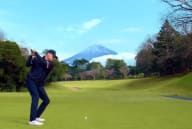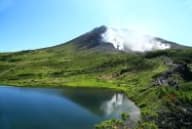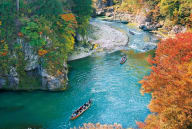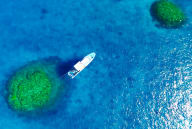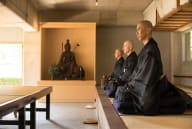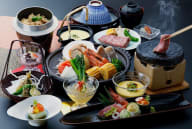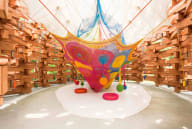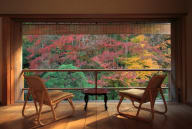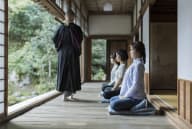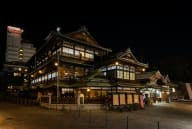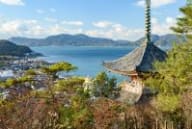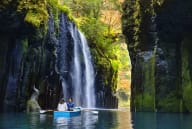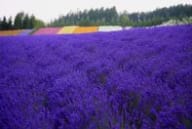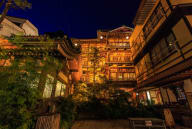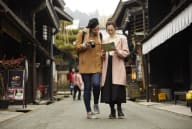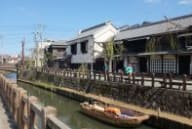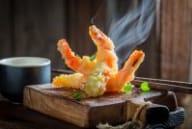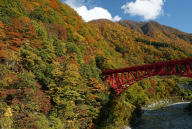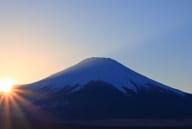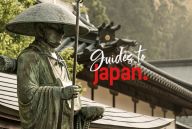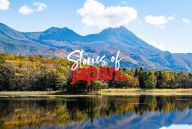
Image: Kokuhō, ©SHUICHI YOSHIDA/ASP ©2025 "KOKUHO" Film Partner
1. Kokuhō
Genre: Drama
Nagasaki, 1964. After the death of his father, Kikuo is taken under the wing of famed kabuki actor Hanjiro Hanai. Alongside the great performer’s only son, Shunsuke, he dedicates his life to the artform - a centuries-old Japanese theatrical tradition known for its costumes, elaborate makeup and innovative stagecraft.
Over the ensuing decades, against the backdrop of stunning stagings of classic kabuki tales, the destiny of the two young disciples entwines and twists - from acting school to the most prestigious stages - and their hearts suffer as much yearning, scandal and glory as their onstage alter egos. Only one of them will become the master of the art.
Based on the best-selling novel by Shuichi Yoshida, Kokuhō (which translates as ‘National Treasure’) stormed the Japanese box office in mid-2025, with demand escalating for months on the back of word of mouth, becoming a true cultural phenomenon.
Location feature: Toyooka City, Hyogo Prefecture

© Toyooka City Hall
One standout location featured in the film is the Eirakukan Kabuki Theatre, a cultural gem that plays a pivotal role in conveying the story’s themes of tradition and legacy.
Located in Izushi Castle Town in Toyooka City, Hyogo Prefecture, Eirakukan is one of the oldest operating kabuki theatres in the Kansai region. Its presence in the film is no coincidence - Izushi itself is a living embodiment of heritage. Often referred to as the 'Little Kyoto of Tajima', this charming town is a beautifully preserved window into Japan’s Edo Period.
Strolling through Izushi feels like stepping back in time. The streets are lined with traditional architecture, samurai residences, and nostalgic charm. The town’s layout has remained largely unchanged for centuries, offering visitors a rare opportunity to walk through living history.
Among its many cultural landmarks is the Shinkoro Clock Tower, built in 1871 and one of Japan’s oldest clock towers. Nearby, the Izushi Castle ruins sit perched on a hill, offering sweeping views and a tranquil atmosphere perfect for reflection. For a deeper glimpse into the town’s feudal past, the Karo Yashiki, once home to a high-ranking samurai family, invites visitors to explore the lifestyle of the warrior class.
2. Sunset, Sunrise
Genre: Drama, Romance

Image: Sunset, Sunrise
The year is 2020, and measures against COVID-19 are starting to affect life all over Japan. Masks, temperature checks and constant sanitising are a necessary annoyance - but for one enthusiastic Tokyoite, the ‘new normal’ brings a thrilling opportunity. Leaving behind his life in the city, young salaryman Shinsaku decides to work remotely and moves to a small town on the Sanriku Coast of Miyagi Prefecture, where he rents an empty house from wary landlord Momoka. Surrounded by the stunning nature of Tohoku, Shinsaku spends his days indulging in his favourite hobby, fishing and discovering the charm of his new neighbourhood. But as scars from the 2011 earthquake and tsunami remain fresh, can the territorial locals accept him as one of their own?
Featuring an all-star cast, this delightful romcom follows Momoka and Shinsaku as they navigate new ground together. With a cast of odd yet lovable locals inhabiting Udahama, it’s hard not to fall in love with this quirky crew as they defend their small fishing town. Heartfelt and authentic, this age-old tale of city meets country offers a glimpse of hope for the future of rural Japan - one full of serendipitous encounters and mouthwatering sashimi.
Location feature: Kesennuma City, Miyagi Prefecture

© Miyagi Perfectural Government
The fictional town of Udahama comes to life on screen through the scenic backdrop of Kesennuma City, a picturesque coastal gem nestled along the Sanriku Coast in Miyagi Prefecture. With its deep-rooted maritime heritage, Kesennuma stands as one of Japan’s most vital fishing ports, where the the sea sets the pace of everyday living.
A visit to the Kesennuma Fish Market offers a glimpse into this vibrant culture. Early morning auctions buzz with energy and the seafood range from sashimi, perfectly grilled seasonal fish to local delicacies that celebrate the bounty of the Pacific Ocean.
Kesennuma’s resilience is equally remarkable. The city was profoundly impacted by the 2011 Great East Japan Earthquake and tsunami, but what stands today is a community rebuilt with purpose and pride. The Kesennuma City Memorial Museum provides a moving tribute to the disaster and the city’s inspiring recovery, offering visitors a powerful reminder of human strength and solidarity.
Another highlight is K-Port, a stylish seaside café founded by acclaimed actor Ken Watanabe. Located near the ferry terminal, K-Port is more than a cozy spot for seasonal teas and ocean views, it’s a symbol of healing and connection. With its warm atmosphere, children’s play area and community-focused events, K-Port embodies the spirit of Kesennuma and its commitment to cultural exchange.
For panoramic views, head to Mt. Anba, where sweeping vistas of Kesennuma Bay and the Pacific await. The mountain is steeped in tradition, home to Osugi Shrine, where locals pray for safe sea voyages and good fortune. The hiking trail is dotted with whimsical landmarks like the Dragon Staircase, Sunrise Terrace and Star Terrace, making it a favourite among nature lovers and photographers.
3. Bushidō
Genre: Drama, Period

Image: Bushidō, ©2024 "BUSHIDO" FILM PARTNERS
Wrongfully accused of a crime, Kakunoshin Yanagida is cast out from his hometown and stripped of his samurai status. Resigned to life in an Edo tenement house with his daughter Okinu, Kakunoshin carves out a meagre living making handcrafted hanko (signature stamps). But when a chance encounter over a game of Go pits him against the unscrupulous merchant Genbee Yorozuya, Kakunoshin is pulled into a world of gambling and debt. For him, Go is no mere pastime - it’s a battlefield where honour itself is at stake. When rumours of the truth behind his exile emerge, Kakunoshin seizes the chance to clear his name and avenge his late wife. But as righteousness collides with reality, it is Okinu who must bear the price of her father’s revenge.
Award winning director Kazuya Shiraishi’s first period drama, Bushidō masterfully blends traditional storytelling with contemporary cinematic techniques. Adapted from a famous rakugo (verbal comedy) piece, the story of Bushidō is brought vividly to life by lead actor and former pop idol Tsuyoshi Kusanagi and supported by a compelling performance from Jun Kunimura. Rich with the spectacle of traditional festivals and the intensity of samurai duels, Bushidō unfolds a tale of honour, pride and sacrifice, meticulously staged like the ancient game of Go.
Location feature: Omihachiman City, Shiga Prefecture

©︎ Biwako Visitors Bureau
If you pay close attention, you can catch a glimpse of our innocent samurai riding through the canals of Hachimanbori. Nestled in the heart of Shiga Prefecture, Hachimanbori is a picturesque canal district in the city of Omihachiman that offers a charming glimpse into Japan’s Edo-period past. Once a bustling hub for merchants and trade, the canal was an essential part of the region’s economic development, connecting Lake Biwa to the town and facilitating the movement of goods.
Today, Hachimanbori is a beautifully preserved area where traditional, white-walled storehouses, wooden merchant homes and stone bridges line the tranquil waterway. Visitors can stroll along the canal paths, take a relaxing boat ride or explore local museums that showcase the town’s rich history and the legacy of the Omi merchants - renowned for their business acumen and ethical practices.
The area is also known for its seasonal beauty: cherry blossoms in spring, lush greenery in summer and vibrant foliage in autumn. Combined with its historical architecture and peaceful atmosphere, Hachimanbori is a perfect destination for those seeking a slower, more reflective travel experience.
4. 366 Days
Genre: Drama, Romance

Image: 366 Days
It’s 2003, and a love story spanning decades has just begun. Bubbly highschooler Miu and quiet senior student Minato dream of a life beyond their sleepy Okinawan town, and when a MiniDisc jumble brings them together, the pair bond over their shared love of music. As they exchange songs romantic sparks fly, and the two start envisioning a life in Tokyo - to the quiet disappointment of Miu’s loyal best friend, Ryusei. But when Miu follows Minato to Tokyo after graduation, she is soon met by the harsh realities of city life. Being a small fish in the big pond brings its challenges, and unexpected circumstances spur Miu and Minato’s lives in different directions. Fast forward to the present, and Miu’s daughter is left to piece together the untold stories of her mother’s past.
Inspired by 366 Nichi, the hit song by Okinawan band HY, this emotionally charged story is one that celebrates the strength of love in all its forms - romantic, familial and platonic. No stranger to the genre, director Takehiko Shinjo’s latest coming-of-age romance is one that many can relate to, with its themes of growth, ambition and having the courage to follow your dreams.
Location feature: Okinawa Prefecture

© Okinawa Convention&Visitors Bureau
Okinawa, Japan’s southernmost prefecture, is a tropical paradise made up of dozens of islands scattered across the sea. Known for its crystal-clear waters, vibrant coral reefs and laid-back island culture, Okinawa offers a unique blend of Japanese and Ryukyuan heritage. Among its many gems, three island groups stand out for travellers seeking sun, sea and serenity: the Kerama Islands, Miyako Island and Ishigaki Island.
Just a short ferry ride from Okinawa’s main island, the Kerama Islands are famed for their exceptional diving and snorkelling spots. The waters here are part of the Kerama Blue, a term coined to describe the stunning clarity and colour of the sea. With abundant marine life and vibrant coral reefs, it’s a haven for underwater explorers. Popular islands like Tokashiki and Zamami also offer hiking trails and quiet beaches perfect for a day trip or overnight stay.
Located further south, Miyako Island is renowned for its powdery white sand beaches and turquoise lagoons. Yonaha Maehama Beach is often ranked among Japan’s best, while the bridges connecting Miyako to nearby islets like Ikema and Kurima offer scenic drives and hidden coves. The island is also known for its relaxed vibe, delicious local cuisine and traditional Okinawan culture.
Ishigaki Island serves as a gateway to remote destinations like Iriomote and Taketomi. The island’s lively town centre offers great food, local crafts and a welcoming atmosphere. Home to lush mountains, pristine beaches and vibrant coral reefs, Ishigaki itself is a treasure.















